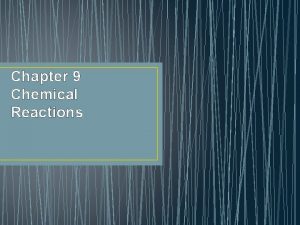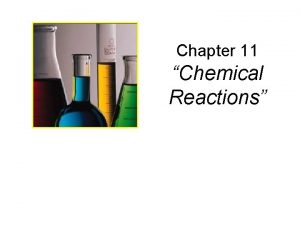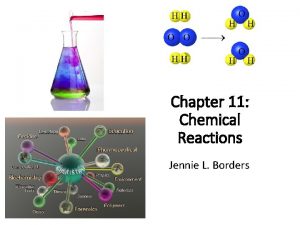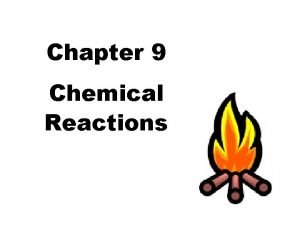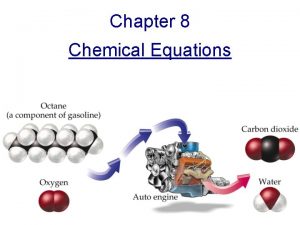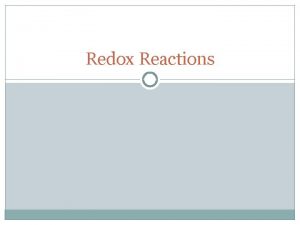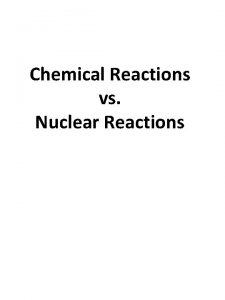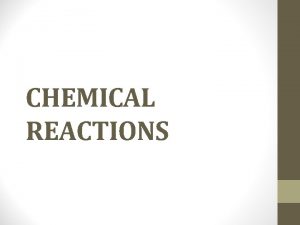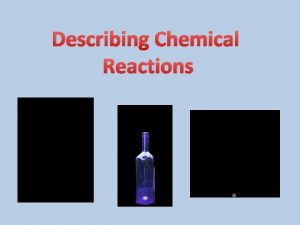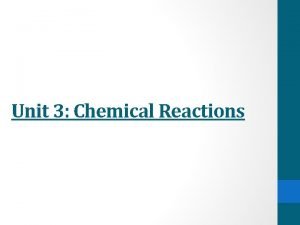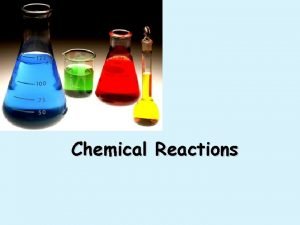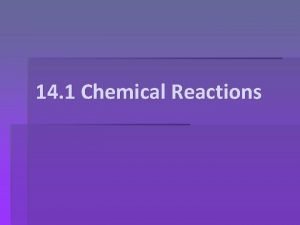Chapter 12 Chemical Reactions Chemical Reactions n A






















- Slides: 22

Chapter 12 Chemical Reactions

Chemical Reactions n. A chemical change takes place when a compound breaks down into new substances. n Chemical reaction: process in which 1 or more substances change to make 1 or more new substances n The chemical and physical properties differ from the original substance.

Signs of a Chemical Reaction n There are 4 signs that a chemical reactions is taking place: – Gas Formation – Solid Formation – Energy Change – Color Change

Signs of a Chemical Reaction n In some reactions, gas bubbles form. n. A precipitate is a solid substance that is formed in a solution. n During certain chemical reactions, energy is given off.

A Change of Properties n Even though there are 4 signs that a reaction is taking place, that does not guarantee that a reaction actually took place. n Example: Gas can be given off when water boils. This is a physical change; not a chemical change.

Chapter 13 Test Corrections n After taking the Ch. 13 Test, what are some areas that you feel you could have spent more time studying? How did you prepare for the test? After taking the test, how would you prepare differently for this test?

Bonds n. A chemical bond is a force that holds 2 atoms together. n For a reaction to take place, the original bond must break and new bonds must form.

Breaking and Making Bonds n How do new substances form in a reaction? – First, bonds must break. – Second, the atoms rearrange. – Last, new bonds form.

New Substances n What is a diatomic molecule? n Example: Sodium is a metal that reacts with water. Chlorine gas is poisonous. When chlorine and sodium react, it produces table salt, which is harmless. n The properties of a diatomic molecule are different from the original substance.

Types of Chemical Reactions n. A synthesis reaction is a reaction in which 2 or more substances combine to form a new compound. n Synthesis example: 2 Na + Cl 2 2 Na. Cl

Types of Chemical Reactions n. A decomposition reaction is a reaction in which a single compound breaks down to form 2 or more simpler substances. n Decomposition CO 2 example: H 2 CO 3 H 20 +

Types of Chemical Reactions n. A single-displacement reaction is one in which a single compound breaks down to form 2 or more simpler substances. n Single-displacement Zn. Cl 2 + H 2 example: Zn + 2 HCl

Types of Chemical Reactions n. A double-displacement reaction is a reaction in which ions from 2 compounds exchange places. n Double-displacement Na. F + Ag. Cl example: Na. Cl + Ag. F

Types of Chemical Reactions n Most reactions can be placed in 4 categories: – Synthesis – Decomposition – Single-displacement – Double-displacement – In all chemical reactions, the product is a different substance than the reactants. § In chemical reactions, properties of substances

Types of Chemical Reactions n Exothermic reactions give off heat and endothermic reactions require heat for the reaction to take place. n Usually exothermic reactions give off heat in the form of fire or gas.

Types of Chemical Reactions n Catalysts speed up chemical reactions while inhibitors slow chemical reactions down. n They are exact opposites of each other and act in totally different ways.

Chapter 12 Review Questions n n n 1) When do chemical changes take place? 2) List 4 signs that a chemical reaction is taking place. 3) During certain chemical reactions, _______ is given off. 4) How do new substances form in a reaction? 5) T/F When diatomic molecules combine, the new substance has different properties from the original substances. 6) Give one example of 2 individual molecules that combine to form a compound.

Chapter 12 Vocabulary Review 1) _____: states that the total mass of the reactants before a chemical reaction is the same as the total mass of the products after the reaction n 2) _____: a description of a reaction using the element symbols and chemical formulas n 3) _____: the substances produced by a chemical reaction n 4) _____: a process in which the atoms of 1 or more substances rearrange to form 1 or more new substances n

Chapter 12 Vocabulary Review n 5) ____: the starting substances in a chemical reaction n 6) ____: a number placed in front of an element symbol or chemical formula in an equation n 7) ____: a reaction in which 1 compound breaks down to form 2 new substances n 8) ____: a reaction in which the negative ions in 2 compounds switch places, forming 2 new compounds

Chapter 12 Vocabulary Review n 9) _____: a reaction in which 1 element replaces another element in a compound n 10) ____: a type of reaction in which 2 or more substances combine to form a new compound n 11) ____: a chemical reaction in which a substance combines with oxygen and releases energy n 12) ____: the minimum amount of energy needed to start a chemical reaction

Chapter 12 Vocabulary Review n 13) ____: a substance that increases reaction rate by lowering the activation energy of a reaction n 14) ____: chemical reactions that absorb thermal energy n 15) ____: a catalyst that speeds up reactions in living cells

Chapter 12 Vocabulary Review n 16) ____: a substance that slows down, or even stops, a chemical reaction n 17) ____: a chemical reaction that releases thermal energy
 Section 2 reinforcement classifying chemical reactions
Section 2 reinforcement classifying chemical reactions Section 2 classifying chemical reactions worksheet answers
Section 2 classifying chemical reactions worksheet answers Are kc and kp equal
Are kc and kp equal Types of reactions
Types of reactions Chapter 10 chemical reactions answer key
Chapter 10 chemical reactions answer key Chapter 9 chemical reactions test answers
Chapter 9 chemical reactions test answers Section 1 chemical changes
Section 1 chemical changes Chapter 9 chemical reactions
Chapter 9 chemical reactions Chapter 8 review chemical equations and reactions
Chapter 8 review chemical equations and reactions Chapter 9 chemical reactions answers
Chapter 9 chemical reactions answers Chapter 8 section 1 chemical equations and reactions
Chapter 8 section 1 chemical equations and reactions Balancing equations chapter 8
Balancing equations chapter 8 Chapter 11 chemical reactions answer key
Chapter 11 chemical reactions answer key Predict the products of the following reactions.
Predict the products of the following reactions. Chapter 19 chemical reactions answer key
Chapter 19 chemical reactions answer key Chapter 11 chemical reactions answers
Chapter 11 chemical reactions answers What is an active metal
What is an active metal Half redox reaction
Half redox reaction Unit 5 chemical reactions answers
Unit 5 chemical reactions answers Empirical formula and molecular formula pogil
Empirical formula and molecular formula pogil Chemical formulas and chemical compounds chapter 7 review
Chemical formulas and chemical compounds chapter 7 review Stoichiometry mole island diagram
Stoichiometry mole island diagram Unit 5 chemical equations and reactions
Unit 5 chemical equations and reactions









